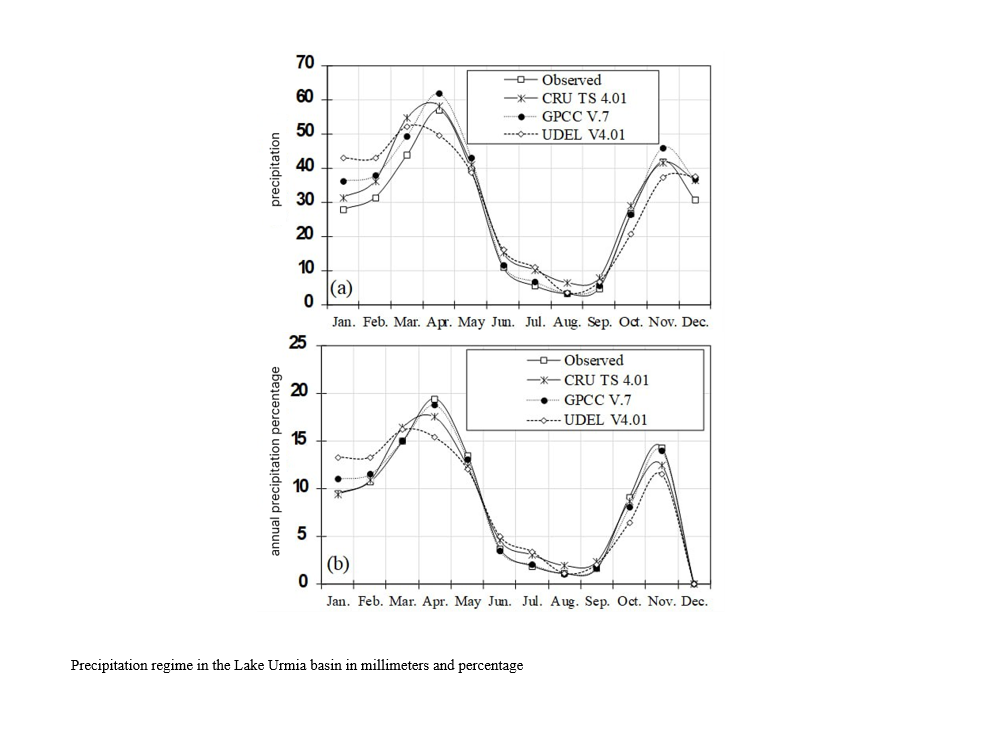Monitoring Drought in the Lake Urmia Basin Using Global Precipitation Data
Keywords:
Drought monitoring , drought forecasting, global precipitation database, climate change, Lake Urmia basin, support vector regressionAbstract
This study investigates the drought status in the Lake Urmia basin using the Standardized Precipitation Index (SPI) and the Standardized Precipitation-Evapotranspiration Index (SPEI) under current and climate change conditions. To monitor past drought events, observational data and precipitation records from global databases—namely CRU, GPCC, and UDEL—were utilized. The results of drought monitoring revealed that severe droughts occurred in the basin during the years 1989, 1991, between 1999 and 2001, and in 2008. Moreover, the evaluation of precipitation datasets for drought monitoring showed that the GPCC database performed best, followed by CRU and UDEL, respectively. Furthermore, to forecast future droughts, a hybrid model combining Support Vector Regression (SVR) and Genetic Algorithm (GA-SVR) was employed. The drought forecasting results indicated that prediction accuracy increases with the extension of the SPI calculation scale, whereas it decreases as the forecast lead time increases. To evaluate future droughts, outputs from 29 General Circulation Models (GCMs) were combined under both the optimistic RCP 2.6 and pessimistic RCP 8.5 scenarios. The evaluation of the hybrid model output demonstrated that temperature in the basin is projected to increase under both scenarios, while precipitation is expected to rise under the optimistic scenario and decrease under the pessimistic scenario. Future drought monitoring based on the SPI revealed that drought frequency will not significantly increase. However, the SPEI results indicated a statistically significant rise in the number of future drought events. The findings suggest that temperature will play a critical role in future drought occurrences. For instance, based on the nine-month SPEI, 12 severe drought events were recorded during the baseline period, whereas under the RCP 2.6 scenario, the number of events is projected to increase to 18, 19, and 19 during the near future (2011–2040), mid-century (2041–2070), and far future (2071–2100), respectively. Under the RCP 8.5 scenario, the corresponding figures are expected to rise to 21, 28, and 38 events, respectively.
References
S. Beguería and S. M. Vicente-Serrano, "SPEI: calculation of the standardised precipitation-evapotranspiration index," ed, 2013.
S. M. Vicente-Serrano, S. Beguería, and J. I. López-Moreno, "A multiscalar drought index sensitive to global warming: the standardized precipitation evapotranspiration index," Journal of climate, vol. 23, no. 7, pp. 1696-1718, 2010, doi: 10.1175/2009JCLI2909.1.
J. C. Adam and D. P. Lettenmaier, "Adjustment of global gridded precipitation for systematic bias," Journal of Geophysical Research: Atmospheres, vol. 108, no. D9, p. 4275, 2003, doi: 10.1029/2002JD002499.
A. Khalili and J. Rahimi, "High-resolution spatiotemporal distribution of precipitation in Iran: a comparative study with three global-precipitation datasets," Theoretical and applied climatology, vol. 118, no. 1-2, pp. 211-221, 2014, doi: 10.1007/s00704-013-1055-1.
G. Azizi, T. Safarrad, H. Mohammadi, and H. Faraji Sabokbar, "Evaluation and comparison of reanalyzed precipitation data for use in Iran," Physical Geography Research, vol. 48, no. 1, pp. 33-49, 2016.
P. S. Katiraie-Boroujerdy, N. Nasrollahi, K. L. Hsu, and S. Sorooshian, "Quantifying the reliability of four global datasets for drought monitoring over a semiarid region," Theoretical and applied climatology, vol. 123, no. 1-2, pp. 387-398, 2016, doi: 10.1007/s00704-014-1360-3.
T. Raziei, I. Bordi, and L. S. Pereira, "An application of GPCC and NCEP/NCAR datasets for drought variability analysis in Iran," Water Resources Management, vol. 25, no. 4, pp. 1075-1086, 2011, doi: 10.1007/s11269-010-9657-1.
U. Schneider, A. Becker, P. Finger, A. Meyer-Christoffer, and B. Z. Rudolf, "GPCC Full Data Reanalysis Version 7.0 at 0.5: Monthly Land-Surface Precipitation from Rain-Gauges built on GTS-based and Historic Data," ed, 2015.
C. Funk et al., "The climate hazards infrared precipitation with stations-a new environmental record for monitoring extremes," Scientific data, vol. 2, p. 150066, 2015, doi: 10.1038/sdata.2015.66.
I. P. D. J. Harris, P. D. Jones, T. J. Osborn, and D. H. Lister, "Updated high‐resolution grids of monthly climatic observations-the CRU TS3. 10 Dataset," International Journal of Climatology, vol. 34, no. 3, pp. 623-642, 2014, doi: 10.1002/joc.3711.
J. H. Stagge, D. G. Kingston, L. M. Tallaksen, and D. M. Hannah, "Observed drought indices show increasing divergence across Europe," Scientific Reports, vol. 7, no. 1, p. 14045, 2017, doi: 10.1038/s41598-017-14283-2.
S. H. Lee, S. H. Yoo, J. Y. Choi, and S. Bae, "Assessment of the Impact of Climate Change on Drought Characteristics in the Hwanghae Plain, North Korea Using Time Series SPI and SPEI: 1981-2100," Water, vol. 9, no. 8, p. 579, 2017, doi: 10.3390/w9080579.
A. J. Koutsouris, D. Chen, and S. W. Lyon, "Comparing global precipitation data sets in eastern Africa: a case study of Kilombero Valley, Tanzania," International Journal of Climatology, vol. 36, no. 4, pp. 2000-2014, 2016, doi: 10.1002/joc.4476.
A. M. El Kenawy and M. F. McCabe, "A multi-decadal assessment of the performance of gauge-and model-based rainfall products over Saudi Arabia: climatology, anomalies and trends," International Journal of Climatology, vol. 36, no. 2, pp. 656-674, 2016, doi: 10.1002/joc.4374.
A. K. Mishra and V. R. Desai, "Drought forecasting using feed-forward recursive neural network," Ecological Modelling, vol. 198, no. 1, pp. 127-138, 2006, doi: 10.1016/j.ecolmodel.2006.04.017.
S. Morid, V. Smakhtin, and K. Bagherzadeh, "Drought forecasting using artificial neural networks and time series of drought indices," International Journal of Climatology, vol. 27, no. 15, pp. 2103-2111, 2007, doi: 10.1002/joc.1498.
A. DannadeMehr, E. Kahya, and M. Özger, "A gene-wavelet model for long lead time drought forecasting," Journal of Hydrology, vol. 517, pp. 691-699, 2014, doi: 10.1016/j.jhydrol.2014.06.012.
S. M. Hosseini-Moghari and S. Araghinejad, "Monthly and seasonal drought forecasting using statistical neural networks," Environmental Earth Sciences, vol. 74, no. 1, pp. 397-412, 2015, doi: 10.1007/s12665-015-4047-x.
J. H. Stagge, I. Kohn, L. M. Tallaksen, and K. Stahl, "Modeling drought impact occurrence based on meteorological drought indices in Europe," Journal of Hydrology, vol. 530, pp. 37-50, 2015, doi: 10.1016/j.jhydrol.2015.09.039.
D. S. Wilks, Statistical methods in the atmospheric sciences. Academic press, 2011, p. 627.
I. Khusniyawati, "The Learning Activities of RBL-STEM: Prototyping a Water-Powered Lamp to Enhance Students' Climate Change Literacy," World Journal of Advanced Research and Reviews, vol. 22, no. 2, pp. 2174-2184, 2024, doi: 10.30574/wjarr.2024.22.2.1671.
H. Seastedt, "Impact of Urban Biodiversity and Climate Change on Children’s Health and Well Being," Pediatric Research, 2024, doi: 10.1038/s41390-024-03769-1.
J. Zhang and Y. Wang, "On the Liability of Small Island States to Compensate for Loss and Damage Associated With Climate Change Impacts," Legal Science in China and Russia, no. 6, pp. 135-144, 2024, doi: 10.17803/2587-9723.2023.6.135-144.
Z. Cao, S. X. Chen, T. Dong, and E. Lee, "Climate Change Uncertainty and Supply Chain Financing," The British Accounting Review, p. 101423, 2024, doi: 10.1016/j.bar.2024.101423.
L. Lu, "In-Depth Analysis of Artificial Intelligence for Climate Change Mitigation," 2024, doi: 10.20944/preprints202402.0022.v1.

Downloads
Published
Submitted
Revised
Accepted
Issue
Section
License
Copyright (c) 2025 Edris Ahmad Ebrahimpour (Author)

This work is licensed under a Creative Commons Attribution-NonCommercial 4.0 International License.











